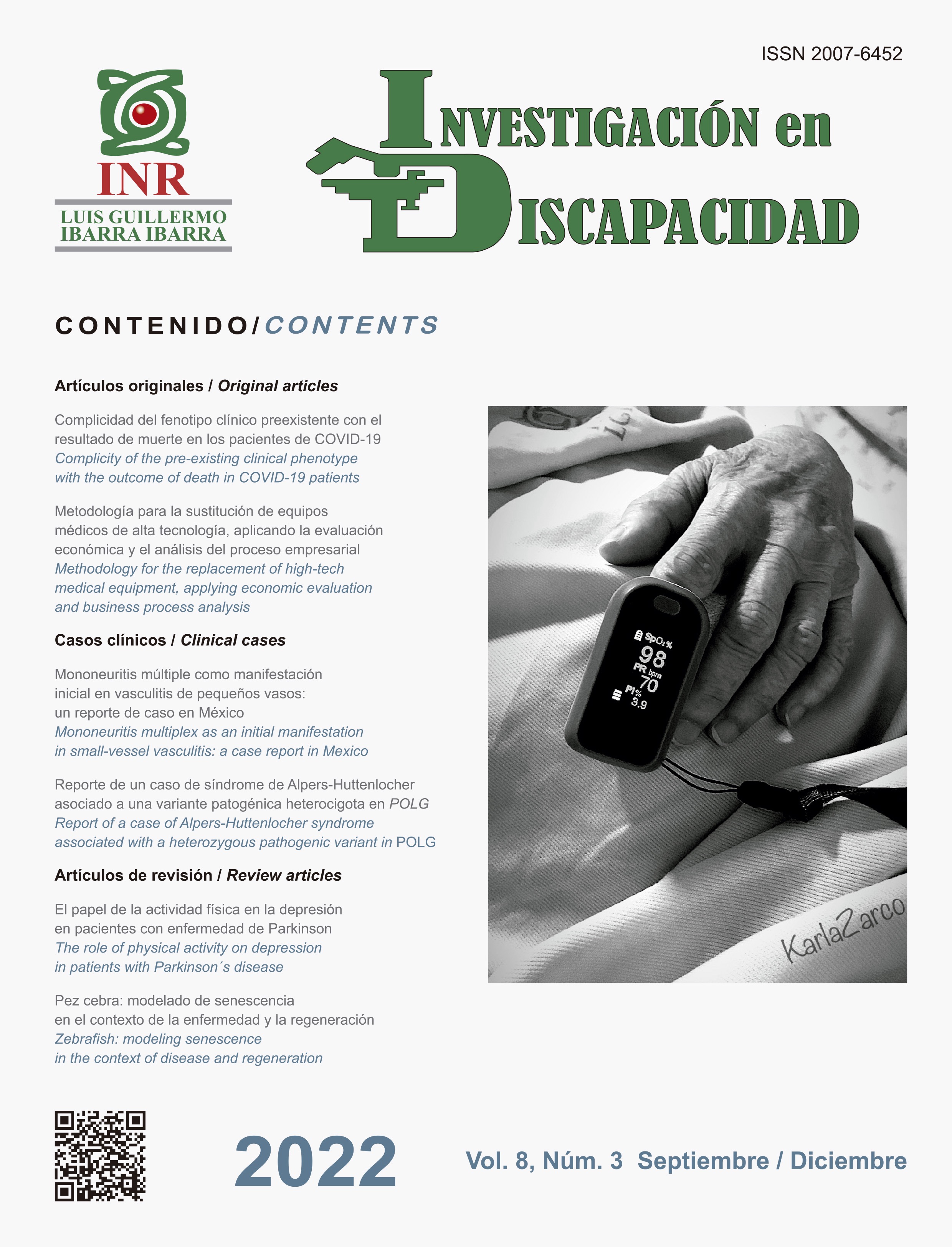Reporte de un caso de síndrome de Alpers-Huttenlocher asociado a una variante patogénica heterocigota en POLG
DOI:
https://doi.org/10.35366/107511Palabras clave:
Síndrome de Alpers-Huttenloche, síndrome hepatocerebral, síndrome por depleción de ADN mitocondrial, POLG, regresión del desarrollo psicomotorResumen
Introducción: el síndrome de Alpers-Huttenlocher (SAH) es una condición de herencia autosómica recesiva asociada a POLG, se caracteriza por la tríada clásica de epilepsia refractaria a tratamiento con componente focal, regresión del desarrollo psicomotor y hepatopatía. Presentamos un caso clínico de una probando mexicana con características de SAH. Caso clínico: se trata de un paciente femenino de seis años y seis meses de edad con desarrollo psicomotor adecuado hasta los cuatro años, después se observa aparente pérdida de fuerza en miembros inferiores de inicio insidioso y presencia de dolor, así como movimientos mioclónicos en ambas extremidades, después se presenta deterioro cognitivo, presenta disartria flácida, adecuado control de cuello, no presenta control de tronco, deformación en equino de ambos pies. Electroencefalograma con múltiples descargas epilépticas, bilirrubina directa 1.69 mg/dL, ácido láctico sérico 20 mg/dL, imagen de resonancia magnética sin alteraciones, tamiz metabólico ampliado normal. Se reporta la presencia de una variante en POLG (c.1433 + 1G > A) en estado heterocigoto considerada patogénica. Conclusión: clínicamente presenta características de SAH, a pesar de presentar sólo una variante patogénica en POLG, no es posible descartar la presencia de variantes no evidenciables por la metodología usada. Hasta donde tenemos conocimiento, es el primer reporte de síndrome de Alpers en un individuo mexicano.
##plugins.generic.pfl.publicationFactsTitle##
##plugins.generic.pfl.reviewerProfiles## N/D
##plugins.generic.pfl.authorStatements##
Indexado: {$indexList}
-
##plugins.generic.pfl.indexedList##
- ##plugins.generic.pfl.academicSociety##
- N/D
Citas
Ropp PA, Copeland WC. Cloning and characterization
of the human mitochondrial DNA polymerase, DNA
polymerase gamma. Genomics. 1996; 36 (3): 449-458.
Alpers B. Diffuse progressive degeneration of the gray
matter of the cerebrum. Arch NeurPsych. 1931; 25 (3):
-505.
Huttenlocher PR, Solitare GB, Adams G. Infantile diffuse
cerebral degeneration with hepatic cirrhosis. Arch
Neurol. 1976; 33 (3): 186-192.
Nguyen KV, Sharief FS, Chan SS, Copeland WC,
Naviaux RK. Molecular diagnosis of Alpers syndrome.
J Hepatol. 2006; 45 (1): 108-116.
Harding B, Alsanjari N, Smith S, Wiles C, Thrush D,
Milles D et al. Progressive neuronal degeneration of
childhood with liver disease (Alpers’ disease) presenting
in young adults. Journal of Neurology, Neurosurgery and
Psychiatry. 1995; 58 (3): 320-325.
Harding BN. Progressive neuronal degeneration of
childhood with liver disease (Alpers-Huttenlocher
syndrome): a personal review. J Child Neurol. 1990; 5
(4): 273-287.
Wiltshire E, Davidzon G, DiMauro S, Akman HO, Sadleir
L, Haas L et al. Juvenile Alpers disease. Arch Neurol.
; 65 (1): 121-124
Saneto RP, Cohen BH, Copeland WC, Naviaux RK.
Alpers-Huttenlocher syndrome. Pediatr Neurol. 2013;
(3): 167-178.
Cohen BH, Chinnery PF, Copeland WC. POLG-Related
disorders. 2010. In: Adam MP, Everman DB, Mirzaa GM
et al., editors. GeneReviews®. Seattle (WA): University
of Washington, Seattle; 1993-2022. Available in: https://
www.ncbi.nlm.nih.gov/books/NBK26471/
Worle H, Kohler B, Schlote W, Winkler P, Bastanier
CK. Progressive cerebral degeneration of childhood
with liver disease (Alpers Huttenlocher disease) with
cytochrome oxidase deficiency presenting with epilepsia
partialis continua as the first clinical manifestation. Clin
Neuropathol. 1998; 17 (2): 63-68.
Horvath R, Hudson G, Ferrari G, Fütterer N, Ahola S,
Lamantea E et al. Phenotypic spectrum associated
with mutations of the mitochondrial polymerase gamma
gene. Brain. 2006; 129(Pt 7): 1674-1684.
ncbi.nlm.nih.gov. 2022. VCV000280017.9 - ClinVar -
NCBI. [On line] [Accessed 23 August 2022] Available
in: https://www.ncbi.nlm.nih.gov/clinvar/variation/2800
/?oq=280017&m=NM_002693.3(POLG):c.1433%20
G%3EA
Baralle D, Baralle M. Splicing in action: assessing
disease causing sequence changes. J Med Genet. 2005;
(10): 737-748.
Tang S, Wang J, Lee NC, Milone M, Halberg MC,
Schmitt ES et al. Mitochondrial DNA polymerase gamma
mutations: an ever expanding molecular and clinical
spectrum. J Med Genet. 2011; 48 (10): 669-681.
inegi.org.mx. 2022. [online] [Accessed 25 August 2022]
Available in: https://www.inegi.org.mx/contenidos/
productos/prod_serv/contenidos/espanol/bvinegi/
productos/nueva_estruc/702825198039.pdf
Van Goethem G, Dermaut B, Lofgren A, Martin JJ, Van
Broeckhoven C. Mutation of POLG is associated with
progressive external ophthalmoplegia characterized by
mtDNA deletions. Nat Genet. 2001; 28 (3): 211-212.
omim.org. 2022. Phenotypic series - PS220110 - OMIM.
[Accessed 25 August 2022] Available in: https://www.
omim.org/phenotypicSeries/PS220110
Von Kleist-Retzow J, Cormier-Daire V, de Lonlay P,
Parfait B, Chretien D, Rustin P et al. A high rate (20%–
%) of parental consanguinity in cytochrome-oxidase
deficiency. Am J Hum Genet. 1998; 63 (2): 428-435.
Baertling F, Al-Murshedi F, Sánchez-Caballero L,
Al-Senaidi K, Joshi NP, Venselaar H et al. Mutation
in mitochondrial complex IV subunit COX5A causes
pulmonary arterial hypertension, lactic acidemia, and
failure to thrive. Hum Mutat. 2017; 38 (6): 692-703.
Lake NJ, Compton AG, Rahman S, Thorburn DR. Leigh
syndrome: one disorder, more than 75 monogenic
causes. Ann Neurol. 2016; 79 (2): 190-203.
Van Goethem G, Lofgren A, Dermaut B, Ceuterick C,
Martin JJ, Van Broeckhoven C. Digenic progressive
external ophthalmoplegia in a sporadic patient:
recessive mutations in POLG and C10orf2/Twinkle.
Hum Mutat. 2003; 22 (2): 175-176.
Da Pozzo P, Rubegni A, Rufa A, Cardaioli E, Taglia I,
Gallus GN, Malandrini A, Federico A. Sporadic PEO
caused by a novel POLG variation and a Twinkle
mutation: digenic inheritance? Neurol Sci. 2015; 36 (9):
-1715
Descargas
Publicado
Cómo citar
Número
Sección
Licencia
Derechos de autor 2022 Instituto Nacional de Rehabilitación Luis Guillermo Ibarra Ibarra

Esta obra está bajo una licencia internacional Creative Commons Atribución 4.0.
© Instituto Nacional de Rehabilitación Luis Guillermo Ibarra Ibarra under a Creative Commons Attribution 4.0 International (CC BY 4.0) license which allows to reproduce and modify the content if appropiate recognition to the original source is given.




